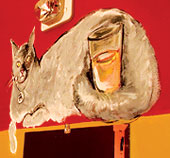
Keep Your Paws Off My Pilsner: This detail of an indoor mural at Westville Pub, by local artist Holly McGee, reflects the increasing interest by business owners in claiming the spaces they lease as truly “theirs” (not unlike the motivation expressed by graffiti writers). As with other murals, indoor works are rarely preserved from one renter to the next. photo by Jonathan Welch
|
Since the very start, mankind has searched for some way of saying “I was here.” From ancient cave art to scribbles on alley walls, these markings tell us fragments of stories from the daily struggles and triumphs of those who lived them. As a historical record, they are invaluable — and yet, almost from the very moment that an unauthorized pigment was rubbed in stone to glorify the day’s hunt, the owner of that cave was probably complaining about his decreasing property values.
But much of the most urgent, meaningful art from the place in history you find yourself in can’t be found in a museum. It may be on a wall. In fact, it may not be considered art at all, but a crime.
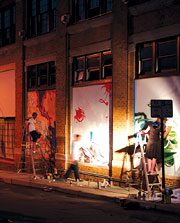
Mad Scientists At Work: Local street muralists Edward D. Harper, Andrew Scott Fansler, Lisa Marie Nance and “Roadkill” at work on Street Science. Sponsored by Arts2People’s Asheville Mural Project, the science-themed collaborative mural on the West Asheville Bank building on Haywood Road blends elements of hip-hop graffiti with illustrative painting and modern graphic design. photo by Zen Sutherland
|
If all the geologists were proven wrong and Mount Pisgah erupted — Vesuvius-like — today, would future archaeologists be able to discern between our illegal “street art” versus commissioned “urban murals,” between criminal vandalism and artistic renovation? The following photos explore this question — and, in keeping with the theme, were taken by two very different photographers: regular Xpress photographer Jonathan Welch and “street” shooter Zen Sutherland.
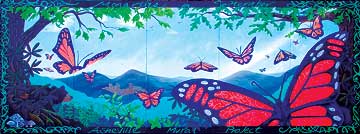
“Monarchs in September”: Far from being seen as annoying petty vandalism, outdoor murals are often viewed by businesses and developers as a means of urban beautification. This well-known mural outside Downtown Books and News was created by the Asheville Mural Project and muralist Blue Broxton. photo by Jonathan Welch
|
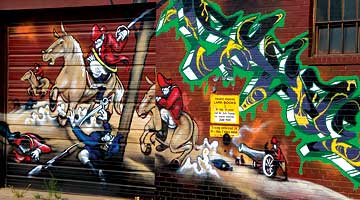
War of the Walls: This detail is from a massive graffiti mural on Carolina Lane, long a haven for local graffiti artists. Works in the alley range from simple “tags” — usually no more than a quickly sprayed name — to the more complex “throw ups” and elaborate “pieces” (short for “masterpieces”). Especially time-consuming and epic works, such as this mural, are often termed “burners.” photo by Jonathan Welch
|
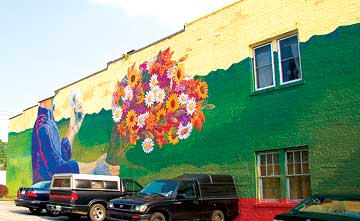
Parking Lot of Art: This outdoor work, “Simple Gift,” was commissioned in 2004 by Mud Hunter Pottery, and was created by noted local muralist Sally Bryenton. The store closed last year, and now that it no longer represents the shop, this striking painting could be seen as an artistic nuisance by potential renters — in effect, graffiti. photo by Jonathan Welch
|
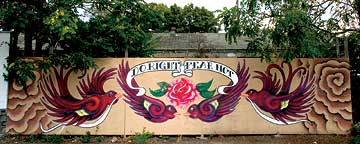
Do Right, Fear Not: This detail is from a “free wall,” or dedicated graffiti space, off Patton Avenue. Free walls are an attempt at compromise between business owners and graffiti artists, or “writers.” Some feel these spaces are vital toward curbing illegal graffiti; others, such as the anti-graffiti group NoGraf Network, believe them to actually increase competition — and vandalism — in urban areas. photo by Jonathan Welch
|
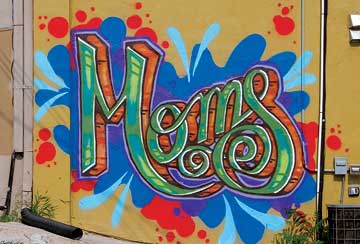
Just Like MOMS Used to Make: Another stylized “throw up” from Carolina Lane, this image was created by local graffiti “crew” MOMS (or Marks On Most Surfaces, among other meanings). In larger cities, where there are often a variety of crews, artistic “battles” for wall space are commonplace. photo by Jonathan Welch
|
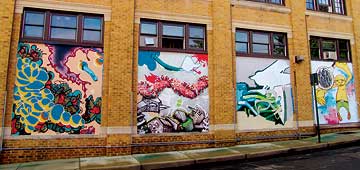
Head Trip: This expressive detail from Street Science shows the unique fusion of styles found in so-called “street art.” Such a work would not be out of place in any modern art museum in the world. photo by Zen Sutherland
|
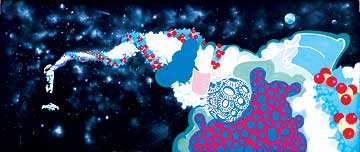
What’s Done Is Done: According to the Asheville Mural Project, Street Science will “remind passers-by on a daily basis of the interconnections at every level of Nature,” and “serve as a catalyst for viewers to contemplate their own integral and active role in the Universe.” That’s fairly high-minded stuff for an art form that, in its unsanctioned incarnation, has been called a “quality-of-life crime” and a symptom of urban decay. photo by Jonathan Welch
|



hey zen,
i was wondering if you’ve noticed the proliferation of a new tag around town; “dirt”?
although, at first, it may not be the most exciting font, the frequency of it is amazing. i have never seen a tagger ‘get up’ in soooo many places int his town.